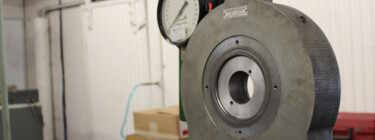The AISC Steel Construction Manual, 13th Edition has this to say about anchor rod nut installation.
“The majority of anchorage applications in buildings do not require special anchor rod nut installation procedures or pretension in the anchor rod. The anchor rod nuts should be “drawn down tight” as columns and bases are erected. This condition can be achieved by following the same practices as recommended for snug-tightened installation in steel-to-steel bolted joints in the RCSC Specification. That is, most anchor rod nuts can be installed using the full effort of an ironworker with an ordinary spud wrench.
When, in the judgment of the owner’s designated representative for design, the performance of the structure will be compromised by excessive elongation of the anchor rods under tensile loads, pretension may be required. Some examples of applications that may require pretension include structures that cantilever from concrete foundations, moment-resisting column bases with significant tensile forces in the anchor rods, or where load reversal might result in the progressive loosening of the nuts on the anchor rods.
When pretensioning of anchor rods is specified, care must be taken in the design of the column base and the embedment of the anchor rod. The shaft of the anchor rod must be free of bond to the encasing concrete so that the rod is free to elongate as it is pretensioned. Also, loss of pretension due to creep in the concrete must be taken into account. Although the design of pretensioned anchorage devices is beyond the scope of this manual, it should be noted that pretension should not be specified for anchorage devices that have not been properly designed and configured to be pretensioned.”
So, in a nutshell, what does this mean?
It means, that in normal circumstances, the normal effort of an ironworker with a regular spud wrench is sufficient to tighten the nuts on anchor bolts. In the event that special pretensioning is required, the design engineer should have carefully designed the anchor assembly specifically for that purpose and there should be detailed instructions so that the pretensioning is carried out properly.

Good Day, when will I know if i will apply torque to post-installed anchor bolts or not, and when will I only use “snug tight” on anchor bolts. Thanks in advance!
@Kenneth- The only time you should need to torque your anchor bolts is when the project engineer specifies it. Otherwise, snug tight should be sufficient.
Hello,
We are using three bolts supplied by your company 2″x34″, 1-1/2×27″, and 1-1/4×27″ all Galvanized F1554G55. These are anchor bolts for steel columns being erected in CA, there are eight per base. I am looking for a torque reference and I am having trouble finding it on your site when I came across this page referring to “Drawn down tight”.
Can you supply me with more info and or torque values? Thank you.
@Kevin- The AISC guidelines say that snug tight is all that is required for anchor bolts, unless the project engineer says otherwise. If that is the case, then he/she should supply you with the necessary information to torque them properly.
What happens if the bolts are not torqued properly?
We keep breaking them…
Is that the result of over or under torqueing?
@Luis- Every application will require a different amount of tension (torque). You may need to consult with the project engineer to determine the proper amount.
What is the structural torque for a a325 lajune bolt? If you can’t get the lajune gun on the bolt? The bolts are 3/4″. Thanks
@Tracy- There are no “official” torque values for TC bolts. The only way to determine the proper amount is to test the bolt in a tension measuring device. If you are having trouble with the bolts or the gun, you might need to replace one or both of them.
I am using heavy tied down brackets my trailer I am using 5/16 by 2 and half inch boats with lock nuts can you please tell me what foot pound torque would be proper to tighten them down
@Rich- I am sorry, but we can’t make torque recommendations for specific applications like that. Apologies.